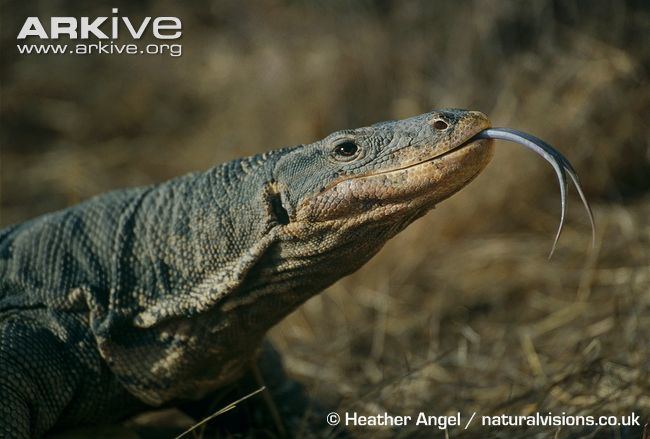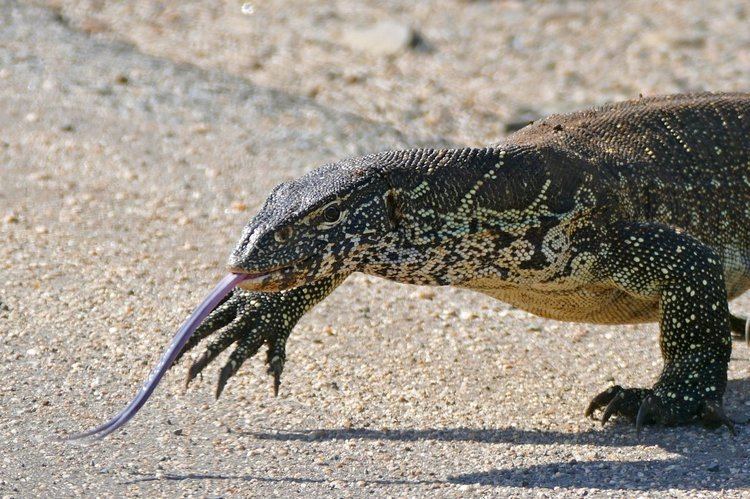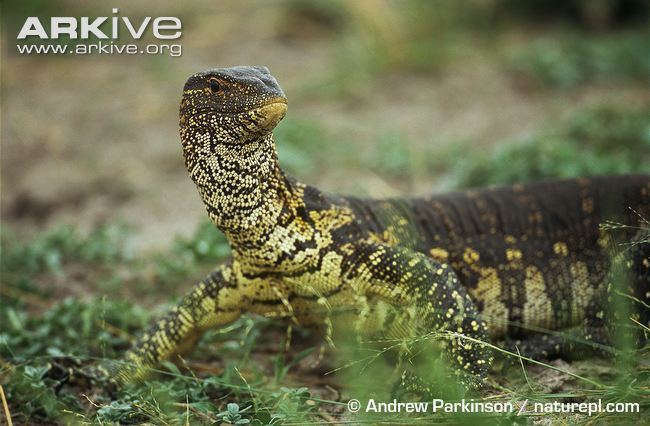Family Varanidae Scientific name Varanus niloticus Higher classification Monitor lizard | Phylum Chordata Suborder Lacertilia Genus Varanus Rank Species | |
 | ||
Similar | ||
The Nile monitor (Varanus niloticus) is a large member of the monitor lizard family (Varanidae) found throughout much of Africa but absent from the west where it is replaced by Varanus stellatus. Other common names include the African small-grain lizard, water leguaan or river leguaan (leguan, leguaan, and likkewaan mean monitor lizard in South African English, and can be used interchangeably).
Contents
- Unboxing nile monitor from backwater reptiles back water reptiles review
- Description
- Range
- Invasive species
- In captivity
- References
Unboxing nile monitor from backwater reptiles back water reptiles review
Description

Nile monitors can grow to about 120 to 220 cm (3 ft 11 in to 7 ft 3 in) in length, with the largest specimens attaining 244 cm (8 ft). In an average-sized specimen, the snout-to-vent length will be around 50 cm (1 ft 8 in). In body mass, adults have been reported to vary widely, one study claiming only 0.8 to 1.7 kg (1.8 to 3.7 lb), others state weights ranging from 5.9 to 15 kg (13 to 33 lb) in big monitors. Variations may be due to age or environmental conditions. Exceptionally large specimens may scale as much as 20 kg (44 lb), but this species weighs somewhat less on average than the bulkier rock monitor. They have muscular bodies, strong legs, and powerful jaws. Their teeth are sharp and pointed in juvenile animals and become blunt and peg-like in adults. They also possess sharp claws used for climbing, digging, defense, or tearing at their prey. Like all monitors, they have forked tongues, with highly developed olfactory properties. The Nile monitor has quite striking, but variable, skin patterns, as they are greyish-brown above with greenish-yellow barring on the tail and large, greenish-yellow rosette-like spots on their backs with a blackish tiny spot in the middle. Their throats and undersides are an ochre-yellow to a creamy-yellow, often with faint barring.

Their nostrils are placed high on their snouts, indicating these animals are highly aquatic. They are also excellent climbers and quick runners on land. Nile monitors feed on fish, snails, frogs, crocodile eggs and young, snakes, birds, small mammals, insects, and carrion.They are also the second largest reptile in the Nile river.
Range

Nile monitors are native to Africa and the species is distributed throughout the entire central and southern regions of the continent, including Sudan and a portion of central Egypt along the Nile river. They are not found in any of the desert regions of Africa, however, as they thrive around rivers. They were also introduced to California, where they aren't invasive and have no known negative impact. 1
Invasive species
In Florida, established breeding populations of Nile monitors have been known to exist in different parts of the state since at least 1990. The vast majority of the established breeding population of the species is in Lee County, Florida, particularly in the Cape Coral and surrounding regions, including the nearby barrier islands (Sanibel, Captiva, and North Captiva), Pine Island, Fort Myers, and Punta Rassa. Established populations also exist in adjacent Charlotte County, especially on Gasparilla Island. Areas with a sizeable number of Nile monitor sightings in Florida include Palm Beach County just southwest of West Palm Beach along State Road 80. In July 2008, a Nile monitor was spotted in Homestead, a small city southwest of Miami. Other sightings have been reported near Hollywood, Naranja, and as far south as Key Largo in the Florida Keys. The potential for the established population of Nile monitors in Lee, Charlotte, and other counties in Florida, to negatively impact indigenous crocodilians (American alligator, Alligator mississippiensis, and American crocodile, Crocodylus acutus) is enormous, given that they normally raid crocodile nests, eat eggs, and prey on small crocodiles in Africa. Anecdotal evidence indicates a high rate of disappearance of domestic pets and feral cats in Cape Coral.
In captivity

Nile monitors are not for beginners; they are often found in the pet trade despite a highly aggressive demeanor and resistance to taming. Juvenile monitors will tail whip as a defensive measure, and as adults they are capable of inflicting moderate to serious wounds from biting and scratching. Nile monitors require a large cage as juveniles quickly grow when fed a varied diet, and large adults often require custom-built quarters. Soil, sand, or bark chippings can be used as substrate and should be deep enough that the monitor can replicate natural digging and foraging behavior. The enclosure should contain things to make a suitable habitat such as rocks, driftwood, plastic plants or hollow logs. A water dish large enough for the lizard to completely submerge should be provided. Nile monitors have a tendency to defecate in the water dish, which requires frequent cleaning. A healthy diet will be varied and contain insects, fish, birds, eggs, and rodents. An insect-heavy diet should be supplemented with calcium powder.
Nile monitors should have a daytime temperature gradient of about 27–32 °C (81–90 °F) and a night time temperature of about 26–27 °C (79–81 °F). A basking spot of approximately 50 °C (122 °F) should be provided at least 12 hours a day. A thermometer can be used to verify the temperature. UVB lighting is required to prevent metabolic bone disease, a common ailment in captive lizards. The humidity should be moderate.
This species is very hardy in captivity when properly maintained. Wild caught animals should be checked for internal parasites.
Albino (amelanistic) specimens have been found in the wild, but there is no evidence that they have ever been propagated in captivity.
